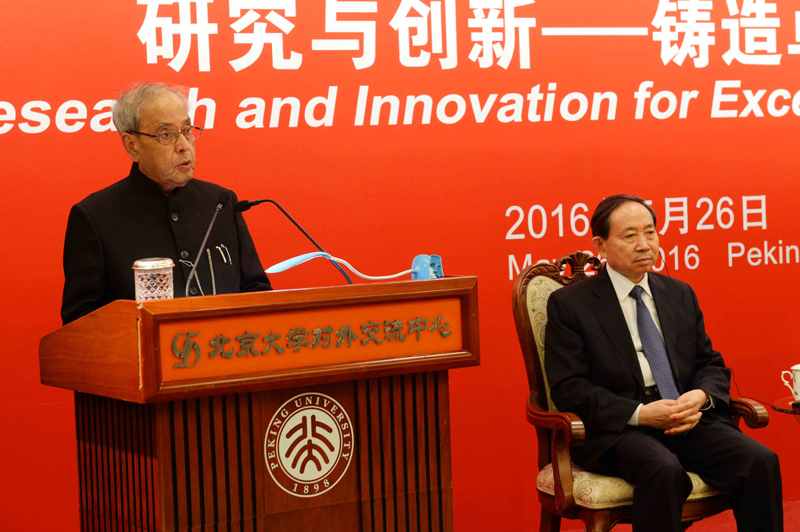
1.At the outset I would like to thank the Peking University and Ministry of Education of the People’s Republic of China for hosting this Round Table. I was very interested to hear the presentations of select academic leaders from both countries and the outcomes of their deliberations. The themes on which you have focused your discussions, are vital for the future of university education in both our countries.
2.They represent the current focus of academic communities world wide – and are an area where the academic community in both China and India could collaborate to great mutual benefit. They are at the core of modernisation and upgradation of standards and content in institutions of higher learning all over the world today.
3. To look back before we look forward, it is relevant to recall that India’s ancient academic advancement, like that of China’s, was world renowned. As far back as the 6th Century, seats of higher learning like Nalanda, Takshashila, Vikramashila, Valabhi, Somapura and Odantapuri had drawn scholars and cultivated contacts and academic exchanges with famed institutions of other countries in the region and beyond. Takshashila was, in a sense, the most ‘connected’ of the Indian universities, a meeting ground of four civilizations – Indian, Persian, Greek and Chinese. Many renowned people came to Takshashila – Panini, Alexander, Chandragupta Maurya, Chanakya, Charaka, and Chinese Buddhist monks Faxian and Xuanzang. Today, Government of India, in partnership with Indian and international foreign partners is taking a number of far reaching initiatives to revive this tradition and create centres of excellence that can be ranked among the leading institutions of the world.
Ladies and gentlemen,
4.Research and innovation are the keystones for widening the country’s production potential. Future growth of nations will result not so much from the utilization of resources with existing technology than from its better usage through more advanced technology. Investment in research is important. While R&D expenditure as percentage of GDP in India is about 0.8 percent at present, we are making concerted efforts to increase this number.
5.A conducive educational eco-system is essential to promote innovation and entrepreneurship. The quality of students passing out from educational institutions is almost always inspired by the quality of teaching, research and orientations towards research and innovation. The inter-linkages of educational institutions - through the trinity of research, innovation and entrepreneurship - with industry are at the core of sustained momentumum in the manufacturing sector, inclusive and balanced economic growth and all round development of a people.
6.As Visitor of 116 national level institutions of higher learning, I have been emphasizing the need to create a collaborative platform for industry and academia to realise the research and innovative potential of our bright students and highly competent faculty. India is a relatively young country with 60% of its population in the age group of 15 to 59. To capitalize on the potential of this segment of educated youth, my Government has launched "Start-up India" aimed at promoting and providing incentives for entrepreneurship and job creation. With over 4,500 start-ups India has the third largest start-up eco-system in the world. New initiatives under the " Start Up India” programme will undoubtedly steer this effort in the right direction. Thus, institutions of higher education have an important responsibility – to harness the entrepreneurial abilities of our youth.
7. The internationalization of higher education through collaborations, faculty and student exchanges, joint research and seminars has always been an integral part of the development of higher education system in India. India has initiated a unique programme GIAN - Global Initiative for Academic Networks. Under this programme, we are engaging faculties from abroad for a short term teaching assignments in higher educational institutions.
Ladies and Gentlemen,
8.Developing countries like India need innovative solutions to issues in renewable energy, climate change, drinking water, sanitation and urbanization. These developmental challenges call for an inspired response from the higher education system. An IMPRINT India programme – which is a Pan IIT and IISc initiative – launched in November last year has identified ten themes that will link the research done by the Indian institutes of national importance with the immediate requirements of the society. Building a sound research eco-system calls for a slew of measures like collaborative partnerships and joint research projects.
9.Today, I am happy to see central institutes of higher learning from India are signing Memorandums of Understanding for co-operation with partner institutions of China. I am confident that these understandings will create a collaborative platform for academic cooperation in the areas of research and education, joint seminars and exchange of faculty and students.
10.Greater exchanges between institutions of higher learning, more cultural festivals and joint research and scholarship programmes would prove that our peoples need not look only to the West to make progress in education, science & technology.
11.India and China are poised to play a significant and constructive role in the 21st Century. When Indians and Chinese come together to address global challenges and build on their shared interests, there will be no limits to what our two peoples can jointly achieve.
With these words, I thank you, once again and wish you success in your collaborations.
